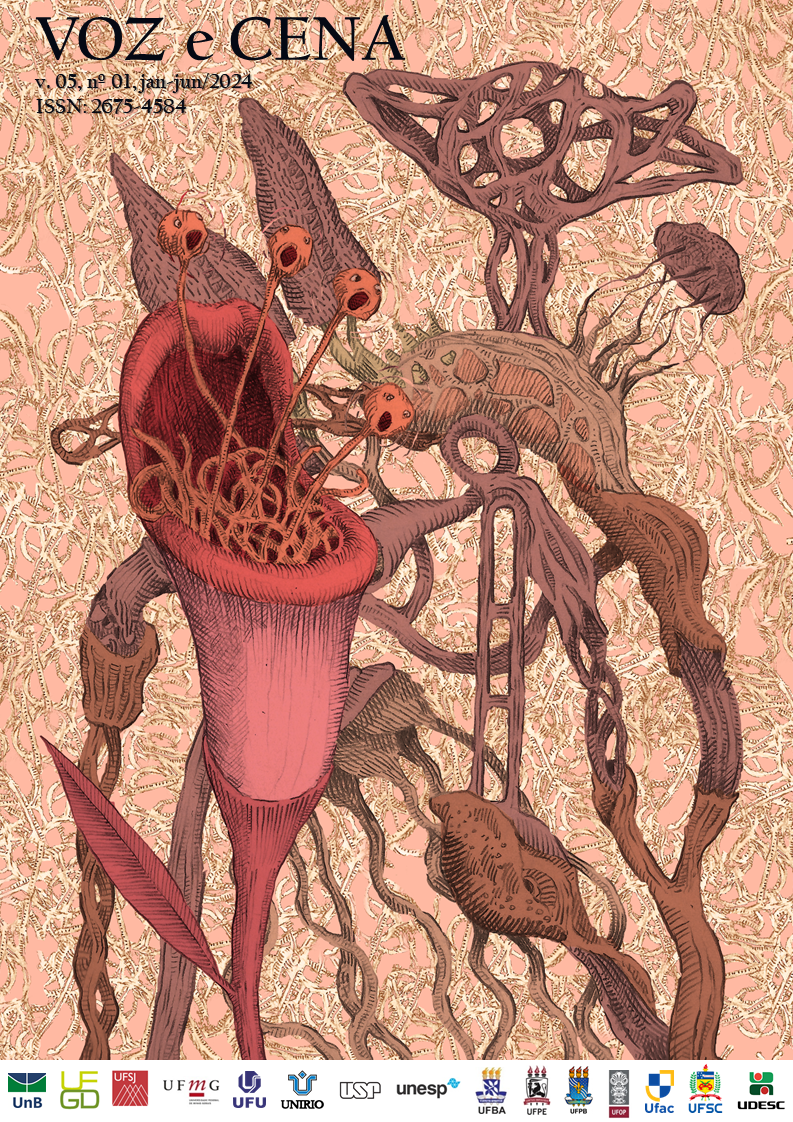Eu toco-Eu respiro-Eu movo-Eu vocalizo-Eu falo
Logos somático rumo à assistência social
DOI:
https://doi.org/10.26512/vozcen.v5i01.54583Palavras-chave:
Práticas somáticas, Logos somático, Assistência Social, Intercorporalização, Prática como PesquisaResumo
Este artigo desenvolve o conceito da autora de logos somático como um enquadramento práxico intercorporalizado que facilita as inter-relações entre vozes individuais e coletivas. A autora se baseia em seu projeto de Prática como Pesquisa (PaR), From Haptic Deprivation to Haptic Possibilities, e utiliza as oficinas em grupo do projeto Are We Still in Touch? como estudo de caso. As oficinas investigam como o toque autodirigido (iniciado e gerido pela própria pessoa) pode apoiar o senso de cuidado, bem-estar e expressão criativa em meio às mudanças sociais catalisadas pela pandemia. Os resultados da investigação sugerem que a escuta somática a si próprio se estende a um sentido intercorporalizado de cuidado com potencial para um impacto social mais amplo.
Downloads
Referências
AHMED, Sara; STACEY, Jackie. Introduction: dermographies. In: AHMED, Sara; STACEY, Jackie (eds.). Thinking through the skin. London: Routledge, 2004. pp. 1-17.
BAINBRIDGE COHEN, Bonnie. Introduction to Body-Mind Centering. In: MILLER, Gill Wright; ETHRIDGE, Pat; MORGAN, Kate Tarlow (eds.). Exploring Body-Mind Centering: an anthology of experience and method. Berkeley, California: North Atlantic Books, 2011. p. 3-11.
BELLARD, Asleigh et al. Vicarious ratings of self vs. other-directed social touch in women with and recovered from Anorexia Nervosa. Scientific Reports, v. 12, article n. 13429, August 2022. Available at: https://doi.org/10.1038/s41598-022-17523-2. Accessed in: June 21, 2024.
BOEHME, Rebecca; OLAUSSON, Hakan. Differentiating self-touch from social touch. Current Opinion in Behavioral Sciences, Elsevier, v. 43, p. 27-33, February 2022. Available at: https://doi.org/10.1016/j.cobeha.2021.06.012. Accessed in: June 21, 2024.
CHARI, Anita. Vocal resonance and the politics of intercorporeality. In: KAPADOCHA, Christina (editor). Somatic voices in performance research and beyond. Abingdon, Oxon: Routledge, 2021. p. 198-211.
DRURY, Lindsey. What’s in a name? Somatics and the historical revisionism of Thomas Hanna. Dance Research Journal, Cambridge, Cambridge University Press, v. 54, n. 1, p. 6-29, April 2022.
EDDY, Martha. Introduction and overview: the what and why of somatic education. In: EDDY, Martha. Mindful movement: the evolution of the somatic arts and conscious action. Wilmington, North Carolina: Intellect, 2016. p. 3-20.
FARNELL, Brenda. Dynamic embodiment for social theory: ‘I move therefore I am’. Abingdon, Oxon: Routledge, 2012.
HANNA, Thomas. Bodies in revolt: a primer in somatic thinking. New York, Holt Rinehart and Winston, 1970.
HANNA, Thomas. The field of somatics. Somatics: Journal-Magazine of the Bodily Arts and Sciences, Novato, California, Novato Institute for Somatic Research and Training, v. 1, n. 1, p. 30-34, Autumn 1976.
JOHNSON, Don Hanlon. Introduction: borderlands. In: JOHNSON, Don Hanlon (ed.). Diverse bodies, diverse practices: towards an inclusive somatics. Berkeley, California: North Atlantic Books, 2018. p. 7-26.
KAPADOCHA, Christina (ed.). Somatic voices in performance research and beyond. Abingdon, Oxon: Routledge, 2021a.
KAPADOCHA, Christina. Somatic logos in physiovocal actor training and beyond. In: KAPADOCHA, Christina (ed.). Somatic voices in performance research and beyond. Abingdon, Oxon: Routledge, 2021b. p. 155-168.
KAPADOCHA, Christina. Tactile renegotiations in actor training: what the pandemic taught us about touch. Theatre, Dance and Performance Training, Abingdon, Oxon, Routledge, v. 14, n. 2, p. 201-215, June 2023.
MACPHERSON, Ben. The somaesthetic in-between: six statements on vocality, listening and embodiment. In: KAPADOCHA, Christina (ed.). Somatic voices in performance research and beyond. Abingdon, Oxon: Routledge, 2021. p. 212-226.
MERLEAU-PONTY, Maurice. The visible and the invisible. Translated by Alphonso Lingis, edited by Claude Lefort. Evanston, Illinois: Northwestern University Press, 1968.
NELSON, Robin. Practice as research in the arts: principles, protocols, pedagogies, resistances. Basingstoke: Palgrave Macmillan, 2013.
PEZZULLO, Pheadra. Resisting Carelessness. Cultural Studies, Abingdon, Oxon, Taylor and Francis, v. 36, n. 3, p. 507-509, December 2020.
STENSTAD, Gail. Merleau-Ponty’s logos: the sens-ing of the flesh, Philosophy Today, v. 37, n. 1, p. 52-61, 1993.
Downloads
Publicado
Como Citar
Edição
Seção
Categorias
Licença
Copyright (c) 2024 Voz e Cena

Este trabalho está licenciado sob uma licença Creative Commons Attribution 4.0 International License.
Os leitores são livres para transferir, imprimir e utilizar os artigos publicados na Revista, desde que haja sempre menção explícita aos autores e à Revista Voz e Cena e que não haja qualquer alteração no trabalho original. Qualquer outro uso dos textos precisa ser aprovado pelos autores e pela Revista. Ao submeter um artigo à Revista Voz e Cena e tê-lo aprovado, os autores concordam em ceder, sem remuneração, os direitos de primeira publicação e a permissão para que a Revista redistribua esse artigo e seus metadados aos serviços de indexação e referência que seus editores julguem apropriados.
Este trabalho está licenciado com uma Creative Commons Attribution 4.0 International License.![]()


7.PNG)


